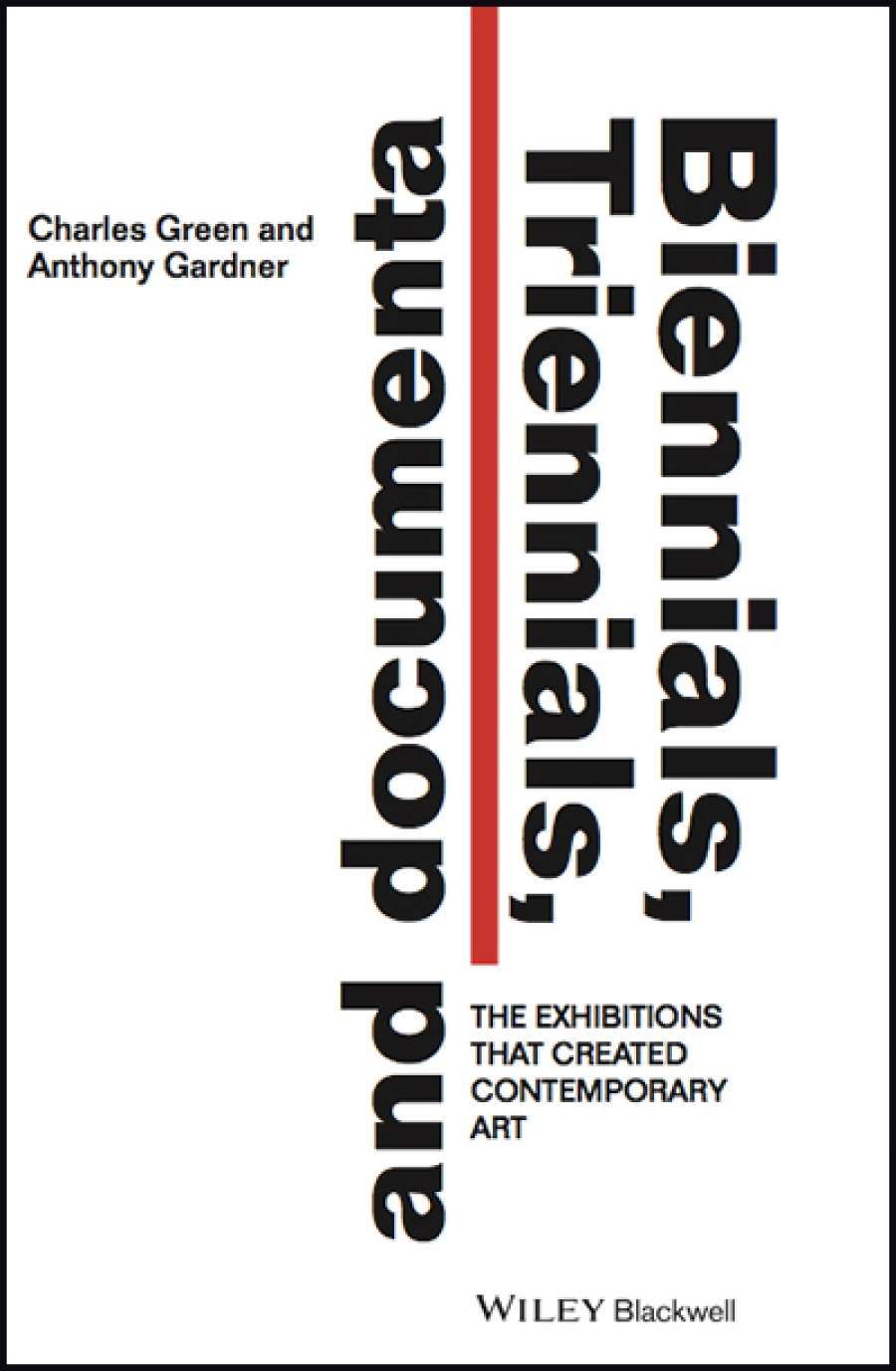
- Free Article: No
- Contents Category: Art
- Custom Article Title: Sophie Knezic reviews 'Biennials, Triennials, and documenta: The exhibitions that created contemporary art' by Charles Green and Anthony Gardner
- Book 1 Title: Biennials, Triennials, and documenta
- Book 1 Subtitle: The exhibitions that created contemporary art
- Book 1 Biblio: Wiley–Blackwell, $42.95 pb, 304 pp, 9781444336658
Faced with this phenomenon, the authors’have set out to do three things: to chart a global history of postwar biennials framed within the economic context of advancing neo-liberalism and local and national politics; to focus on exhibitions of particular historical significance as discrete case studies; and, most importantly, to draw conclusions about the systemic effects of these exhibitions on the broader field of contemporary art.
While most mega-exhibitions are launched with optimistic rationales pivoting on cultural munificence, the true benefits of such events have been viewed equivocally. Their critical reception ranges from championing their socially subversive potential to a demonising their existence as colonialist relics (with antecedents in nineteenth century world fairs) or enterprises complicit with advanced capitalist economies and their aspiration to increasing cultural capital and tourist flows, as well as political expedience in boosting the interests of their corporate sponsors. They have also been dismissed as ‘festivalism’ – art as a spectacular event-based form of pageantry.
Green and Gardner negotiate their critical path with an awareness of mega-exhibitions’ double-edged nature. They pay close attention to the political vicissitudes of each exhibition they foreground, while continually framing their analysis within the wider condition of the global. The last aspect is crucial, as the authors are keen to differentiate the term ‘globalisation’ from ‘globalism’: the former understood as inescapable worldwide transformations in political economies; the latter defined as ‘the self-conscious desire to be seen as global’. Although biennials and triennials have taken place across a spectrum of locales with historically specific circumstances, political players, and cultural ambitions, their placement within this dialectic of globalisation and globalism is a key hermeneutic of the text.
Each of the mega-exhibitions is distinguished by particular characteristics. documenta 5 (1972) was defined by the prominence of its Swiss curator Harald Szeemann. This illustrates the rise of the ‘star-curator’ as a charismatic independent figure whose status eclipses that of any of the artists featured in the exhibition. documenta 5 also represented the beginnings of curators wresting from art historians and art museums the task of decreeing the art-historical canon, effectively usurping their roles as arbiters of contemporary art. The Third Biennale of Sydney (1979) and the XV Bienal de São Paulo (1979) were emblematic of a second wave of biennials, located in the world’s peripheries yet initiating vigorous dialogues that turned on artistic translation across geographic divides. Structured as ‘cultural encounters’, these biennials absorbed the methods of global exhibition-making while bringing local artistic practices to the fore, resulting in new configurations of internationalism.
The second Bienal de La Habana (1986) represented the emergence into the international arena of a biennial not staged in a First or Second World nation. In its explicit renouncement of European or American artists, it formed an ‘alliance of the “non-aligned”’, a South-to-South dialogue that further transformed the internationalist discourse of contemporary art by filtering it through the perspective of a critical post-colonialism. The Asian Art Show, Fukuoka (1979); Asia-Pacific Triennial, Brisbane (1993); Gwangju Biennale (1995); and the Shanghai Biennale (2000) re-inflected this discourse in their varied endeavours to define contemporary art in Asian regional terms.
 Tomas Saraceno (Argentina/Germany), ‘Aerocene’ Performance (photograph by A. Naroditsky, courtesy of the Antarctic Biennale)
Tomas Saraceno (Argentina/Germany), ‘Aerocene’ Performance (photograph by A. Naroditsky, courtesy of the Antarctic Biennale)
During this period, contradictions nonetheless emerged between the desire to celebrate cultural difference and the necessity to subject it to critique, promote art in populist terms or to allow its anti-institutionalist drives full sway. A successive wave of biennials including the Second Johannesburg Biennale (1997) and the Emergency Biennale in Chechnya (2005–8) reframed biennials in terms of locations in crisis, thematising the realpolitik of migration, war, and displacement. Political activism and critique also intersected with recent exhibitions such as the 13th Istanbul Biennial (2013) and the 19th Sydney Biennale (2014), where anger mounted against authoritarian regimes or corporate sponsors profiteering from detention centres. In spite of the text’s wide-ranging focus, this dimension of activism is effectively traced, anticipating more focused studies such as the newly published title by Sternberg Press, I Can’t Work Like This: A reader on recent boycotts and contemporary art (2017).
Three terms are leitmotifs in Biennials, Triennials, and Documenta: ‘neoliberalism’, ‘globalism’, and ‘contemporary’. However, a more interesting one that hovers in the interstices of the text is ‘entanglement’. Appearing almost as frequently as the other three, this term not only does more to conjure the complicated tensions within the undertaking of biennials/triennials but shrewdly describes the mutually constitutive relationship between the flourishing of mega-exhibitions and the lineaments of contemporary art. This mutuality becomes the ultimate argument of the text, albeit one that has been manifestly propounded by art historian Terry Smith, as well as receiving its most theoretical interrogation by philosopher Peter Osborne.
 An installation at the Venice Biennale in 2009
An installation at the Venice Biennale in 2009
(photograph by Godromil via Wikimedia Commons)
The topography of these large-scale exhibitions is examined through a scholarly method that displays impressive art-historical research alongside an evaluation of discrete exhibition scenarios in rigorously analytical terms. The result is an intricate historical mosaic in tandem with acute critical judgements on mutations in the meaning and consequences of contemporary art. If there is a downside to Green and Gardner’s text, it is that its scrupulous historical detail results in a certain dry positivism. Notwithstanding, Biennials, Triennials, and Documenta is destined to become a key text in the historiography of mega-exhibitions.


Comments powered by CComment